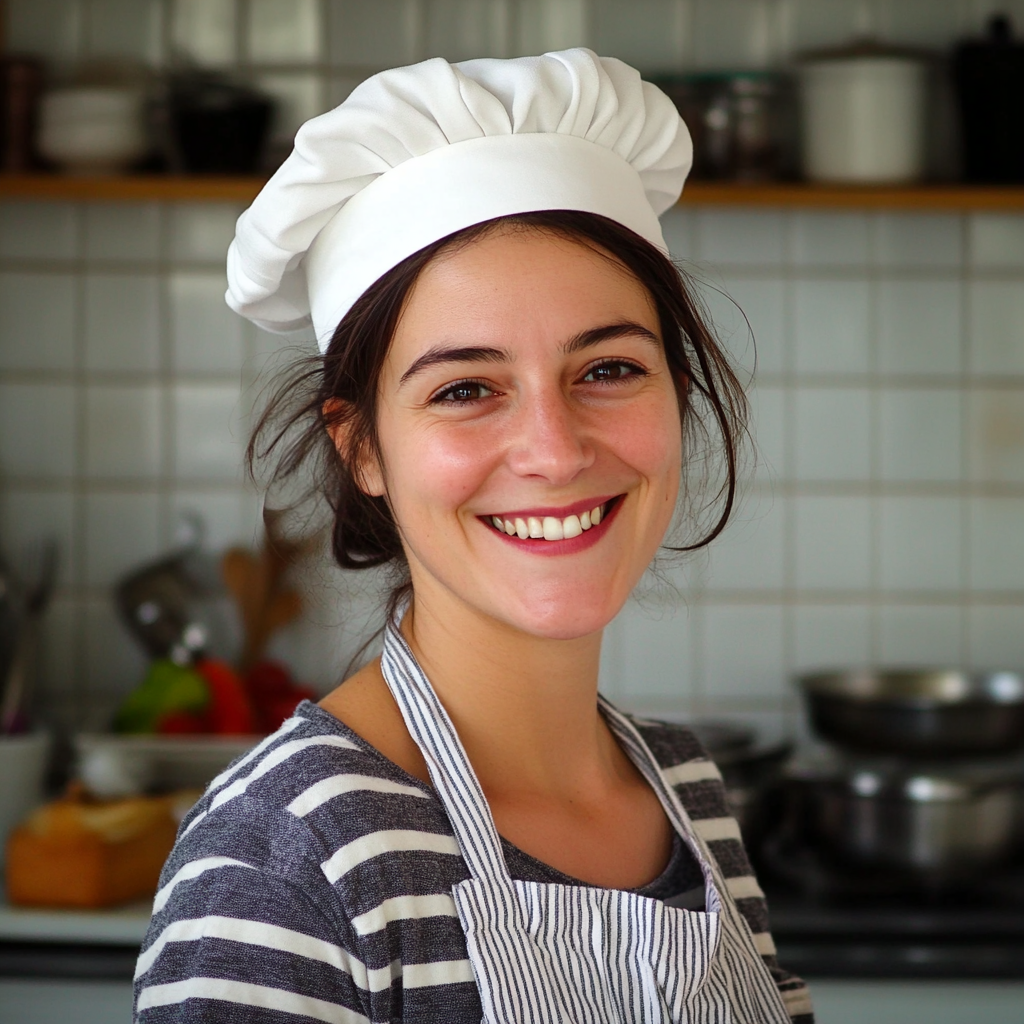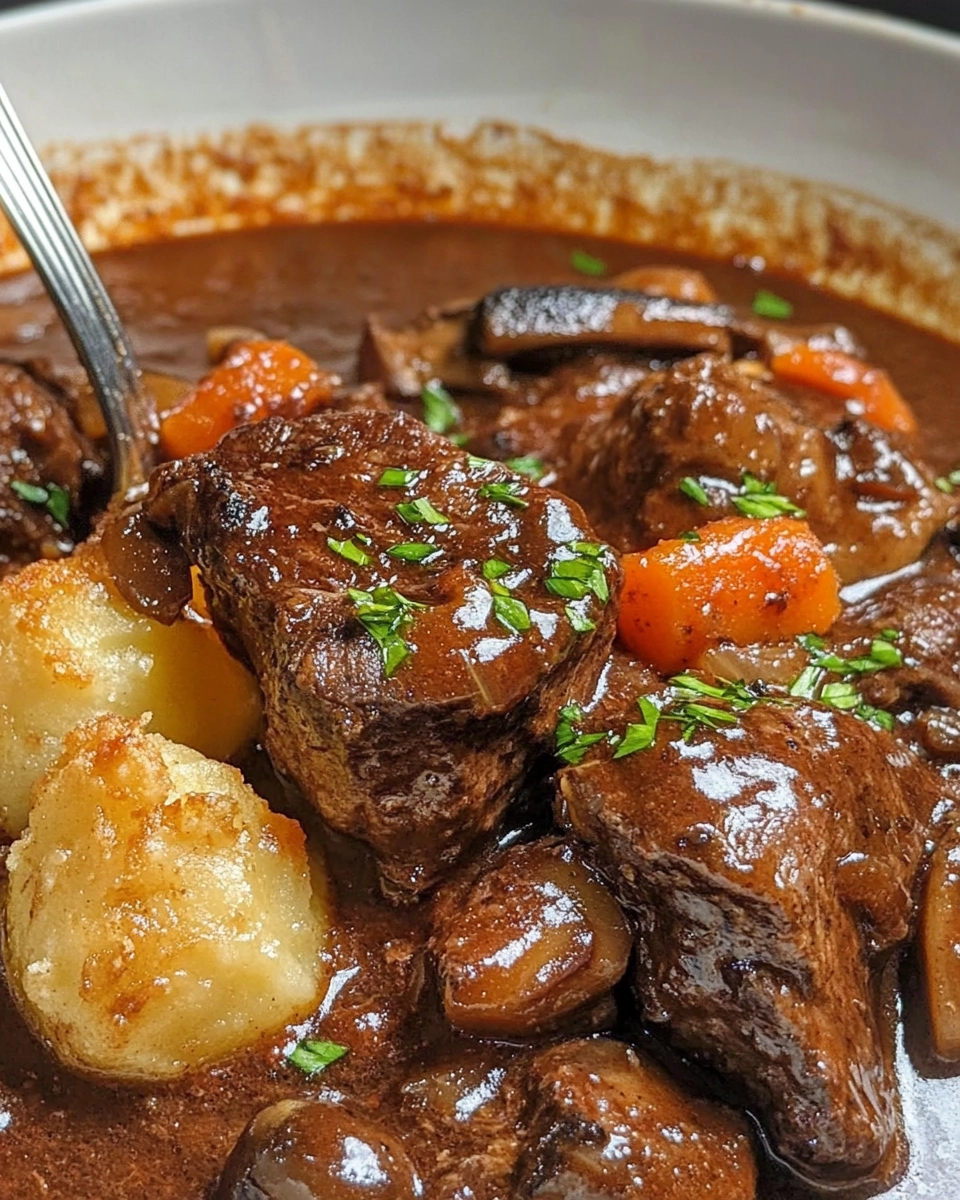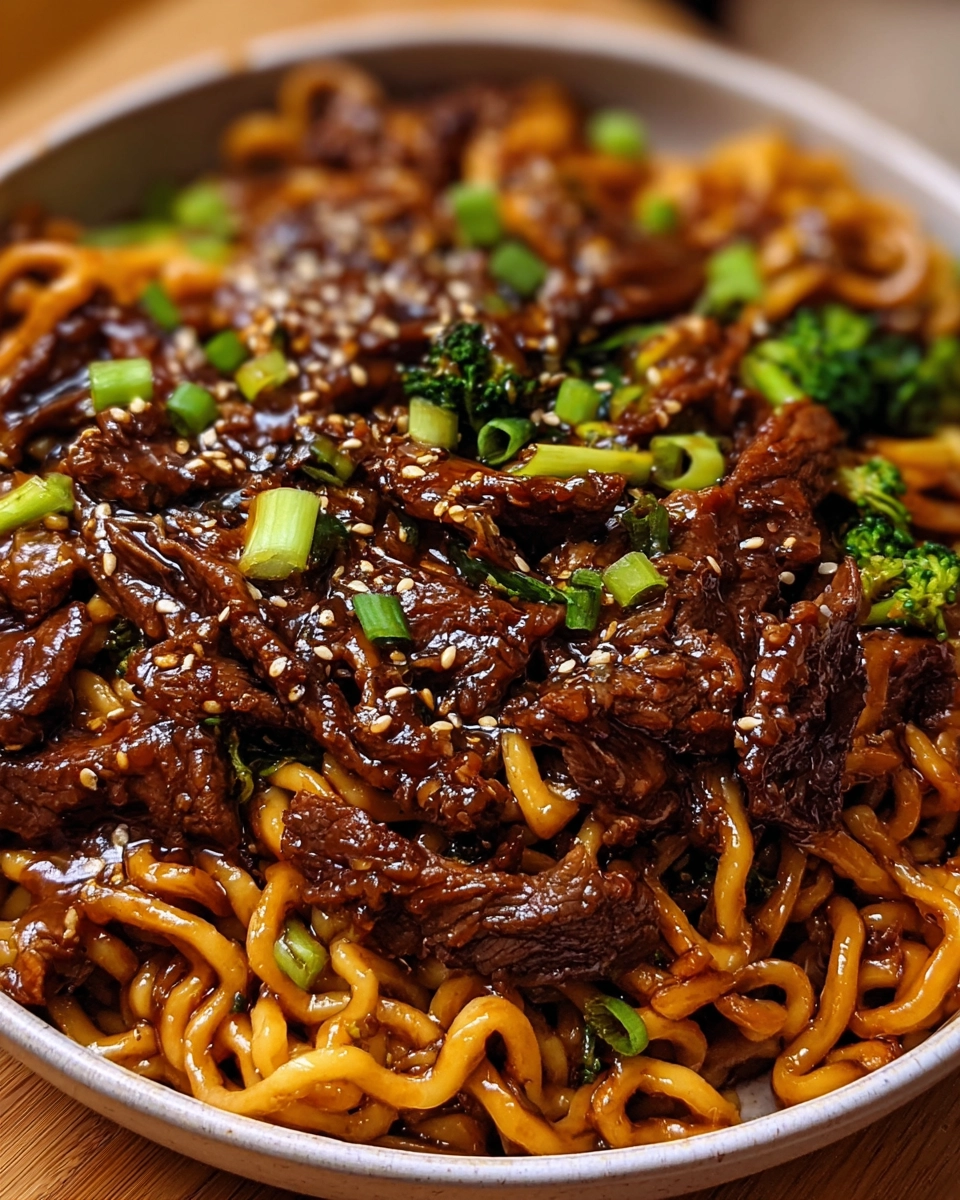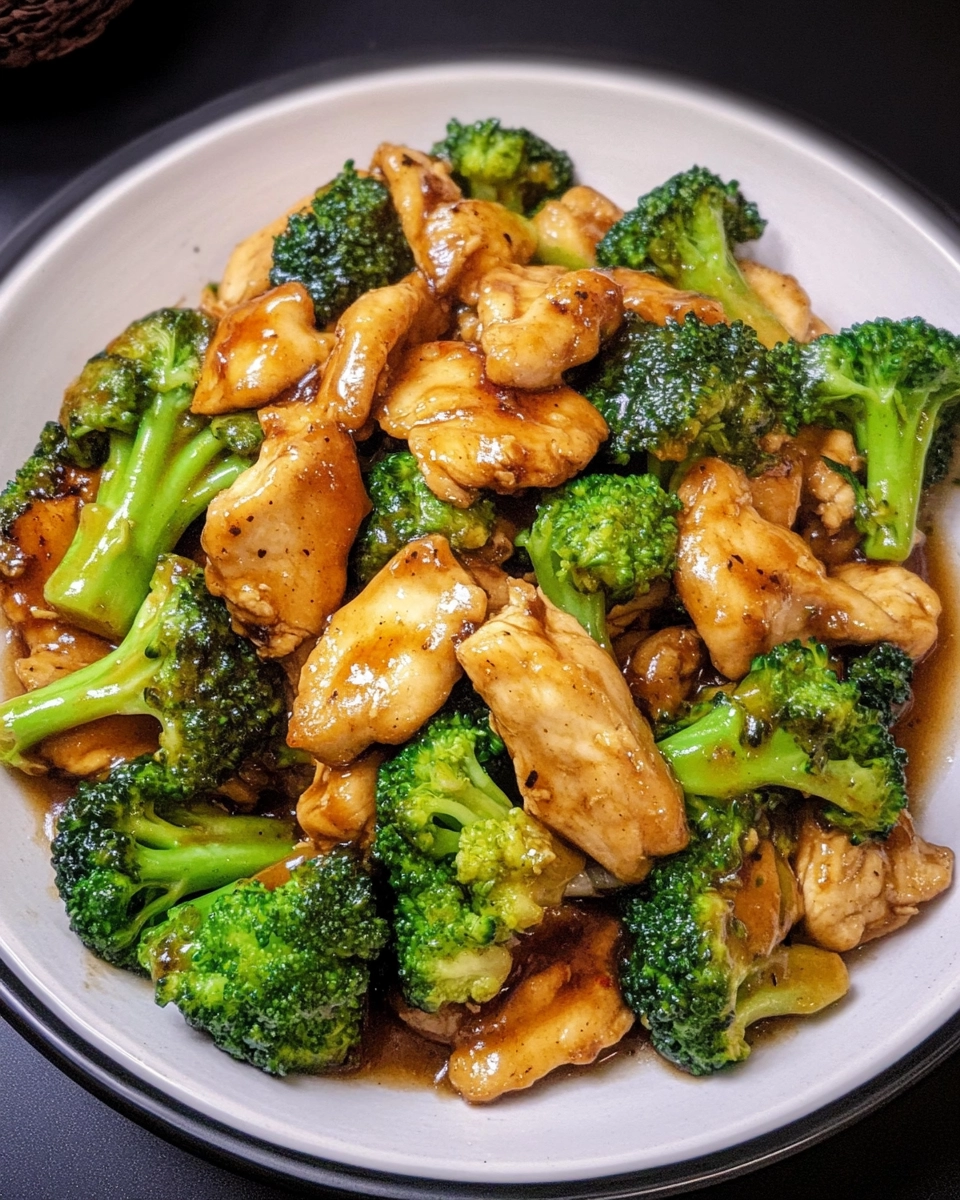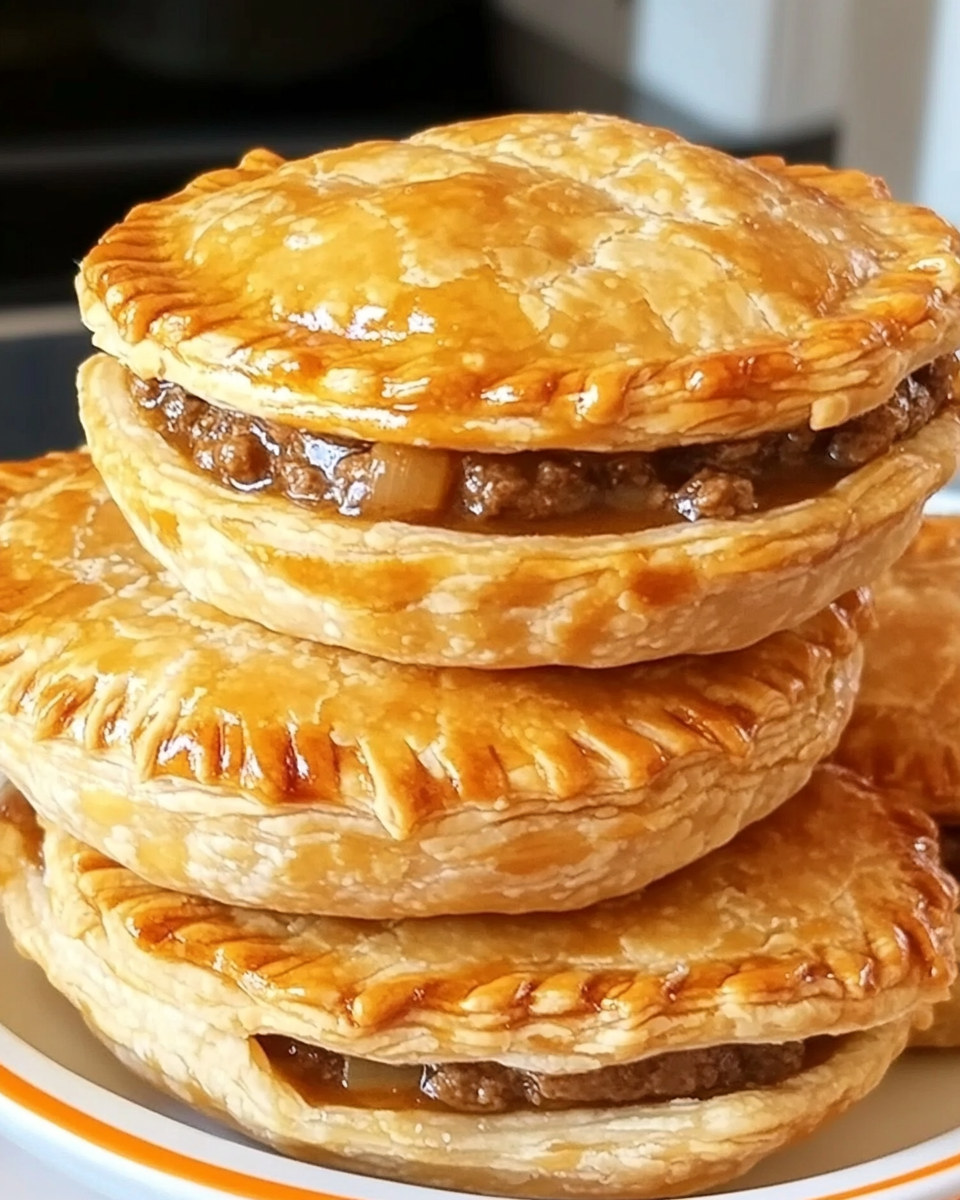Introduction:
Slow-Braised Lamb Shanks in Red Wine and Herb Reduction is more than a recipe. It’s a story simmered slowly in my kitchen just outside Asheville, North Carolina, where the mountains hum and my Dutch oven works overtime.
My name’s Maggie Rae Donovan. I’m a 42-year-old home cook, not a trained chef or culinary school alum, but a woman who has spent the last 25 years falling in love with food—burnt onions, happy accidents, and all.
I learned to cook standing on a wooden chair in my grandmother’s kitchen. Her hands, floured and firm, showed me how to fold biscuit dough, how to season without measuring, and most importantly, how food invites people in. In our Southern home, butter was measured with the heart, and a stew pot meant everyone stayed for seconds.
As life moved forward—becoming a nurse, raising two girls, and moving across states—cooking remained my anchor. Tight budgets made me resourceful. Celebrations gave me room to play. But in the everyday, in the “just because” meals, I found joy.
Some of my best dishes came from happy mistakes. A lemony mishap became my family’s favorite sauce. Once, I swapped breadcrumbs for pretzels and created what we now call “crunchy chicken.” That’s home cooking for you—flawed, flexible, full of heart.
Now, I share recipes from my blog, drop banana bread on neighbor’s porches, and teach home cooks that you don’t need copper pans or imported spices to create magic. What you need is time, intention, and maybe just a little butter.
So today, I’m opening the door to a dish that’s steeped in old-world comfort and Southern patience: fall-apart slow-braised lamb shanks, simmered in a deep red wine herb sauce that warms you down to your bones.
Check out Tender Red Wine Braised Lamb Shanks with Rosemary & Root Vegetables for another cozy lamb variation you’ll love.

Table of Contents
What Are Slow-Braised Lamb Shanks?
Understanding the Cut: Why Lamb Shank Works
Lamb shanks come from the lower leg portion of the lamb, a part full of tough connective tissue and bone. That might sound like a challenge, but in fact, it’s a gift. When slow-braised, the meat transforms into something deeply tender and richly flavored. The bone releases collagen into the cooking liquid, adding natural thickness and depth.
This isn’t the kind of meat you grill or flash-fry. Lamb shanks demand patience and reward it beautifully.
The Slow-Braising Method Explained
So, what is slow braising? It’s the technique of searing meat at high heat, then simmering it slowly in liquid—like red wine and broth—until it’s so tender it falls apart with a fork. In this dish, that liquid becomes a red wine and herb reduction, thickened naturally as it cooks, absorbing the flavor of garlic, rosemary, bay leaf, and thyme.
Braising happens in stages:
- Sear the shanks for deep flavor.
- Build your base: aromatics, wine, and herbs.
- Cover and simmer low for hours.
- Uncover near the end to reduce and thicken.
By the time it hits the plate, this dish has depth, warmth, and soul—and it only gets better the next day.
Discover Mediterranean-Style Braised Lamb Chops if you want a quicker lamb dish with the same heart.
Essential Ingredients for Red Wine and Herb Reduction
Choosing the Right Lamb Shanks
For a truly satisfying Slow-Braised Lamb Shanks in Red Wine and Herb Reduction, you want meaty, bone-in lamb shanks—around 1 to 1.5 pounds each. These are usually from the hind shank, and they need marbling and connective tissue to create the kind of tenderness you’ll remember for weeks.
Ask your butcher for evenly sized shanks, ideally with a bit of surface fat, which helps develop flavor during the sear and adds richness to the braising liquid. Don’t trim too much—the fat will mostly render out while cooking.
Building Flavor with Aromatics & Herbs
This dish begins with the aromatic trinity of Mediterranean braises:
- Garlic – At least 4–6 cloves, smashed or minced
- Onion – Yellow or sweet onions, chopped
- Carrots & Celery – Finely diced for sweetness and body
These are sautéed in olive oil or butter after searing the lamb, forming a deep, fragrant base. Then, come the herbs:
- Rosemary – Woody, piney, and earthy
- Bay Leaf – Subtle but essential for background depth
- Thyme – Adds a soft, warm note
- Parsley – Chopped fresh, stirred in at the end for brightness
- Optional: A strip of orange zest or a few crushed juniper berries for complexity
You’ll also want to season generously with kosher salt, black pepper, and maybe a pinch of smoked paprika or cumin if you want a Southern flair.
Selecting the Right Red Wine
Red wine is more than just liquid—it’s the soul of this dish. You don’t need a fancy bottle, but you do want something dry, bold, and tannic:
| Best Red Wines for Braising Lamb | Why They Work |
|---|---|
| Cabernet Sauvignon | Full-bodied, earthy |
| Syrah/Shiraz | Peppery, smoky notes |
| Zinfandel | Jammy, rich flavor |
| Merlot | Softer, velvety texture |
Avoid anything too sweet. If you wouldn’t drink it, don’t cook with it. You’ll need about 1 to 1.5 cups of wine—enough to deglaze the pan and partially cover the shanks in the braising pot.
Bonus Flavor Boosters
While the base of this dish is rustic and simple, a few extras can elevate it:
- Tomato Paste – Adds body and umami to the sauce
- Beef broth – Deepens the flavor when added to the wine
- Balsamic vinegar – For acidity and sweetness if wine is too sharp
- Flour or cornstarch – Optional, for thickening at the end (though the sauce usually reduces naturally)
Don’t miss our Fall-Off-the-Bone Lamb Shanks with Red Wine Reduction for another way to build layers of deep, slow-cooked flavor.
Step-by-Step – How to Braise Lamb Shanks to Perfection

Step 1: Sear the Lamb Shanks
Begin by patting your lamb shanks dry with paper towels—moisture is the enemy of a good sear. Then season generously with kosher salt and black pepper on all sides.
In a large Dutch oven or heavy pot, heat 2–3 tablespoons of olive oil over medium-high heat. Once hot, add the shanks (working in batches if needed) and sear on all sides—about 3 to 4 minutes per side—until deeply golden and caramelized. This step locks in flavor and builds the base for your sauce.
Transfer the seared shanks to a plate and set aside.
Step 2: Build the Flavor Base
In the same pot, lower the heat to medium. Add:
- 1 large onion (chopped)
- 2 carrots (diced)
- 2 celery stalks (diced)
- 6 garlic cloves (smashed or minced)
Sauté for 5–7 minutes until the vegetables are soft and fragrant. Then stir in:
- 2 tablespoons of tomato paste
- A pinch of smoked paprika or ground cumin (optional)
Let the tomato paste cook for about a minute to deepen its flavor.
Step 3: Deglaze and Simmer
Pour in 1½ cups of dry red wine, scraping up the browned bits at the bottom of the pot (those are pure flavor). Let the wine simmer for 2–3 minutes to cook off the alcohol.
Add:
- 2 cups beef broth
- 2 sprigs rosemary
- 2 sprigs thyme
- 1 bay leaf
- Salt and pepper to taste
Return the lamb shanks to the pot, nestling them in so the liquid comes up ⅔ of the way.
Step 4: Braise Low and Slow
Cover with a lid and transfer the pot to a preheated oven at 325°F (165°C). Let it braise for 2½ to 3 hours, turning the shanks once halfway through. You’ll know they’re ready when the meat is fork-tender and nearly falling off the bone.
Toward the end of cooking, remove the lid to allow the sauce to reduce and thicken. You can also simmer on the stovetop for an additional 10–15 minutes uncovered, if needed.
Step 5: Serve and Shine
Once done, remove the lamb shanks carefully—they’ll be incredibly tender. Strain the sauce if you want it silky-smooth, or leave it rustic with vegetables intact. Spoon generously over the shanks and garnish with fresh chopped parsley and a touch of lemon zest.
Looking for inspiration? Try our Slow-Braised Holiday Lamb Shanks in Red Wine for a celebratory version packed with festive flavors.
Red Wine and Herb Pairings That Elevate the Dish
Best Red Wines for Braised Lamb Shanks
When it comes to Slow-Braised Lamb Shanks in Red Wine and Herb Reduction, the wine isn’t just an ingredient—it’s the backbone of the flavor. A good wine enhances the lamb’s richness, balances the earthy herbs, and infuses the sauce with bold depth.
Here’s a list of excellent red wines for braising:
| Wine Type | Flavor Notes | Why It Works |
|---|---|---|
| Cabernet Sauvignon | Dark berries, pepper, oak | Bold enough to stand up to lamb fat |
| Syrah/Shiraz | Smoky, spicy, full-bodied | Adds complexity and warmth |
| Zinfandel | Jammy fruit, high alcohol | Intensifies sweetness in the sauce |
| Merlot | Soft, smooth, plum, mocha | Creates a velvety, mellow braise |
| Malbec | Blackberry, vanilla, cocoa | Great for rustic, hearty reductions |
Avoid wines labeled “cooking wine”—they’re often too salty or acidic. Use something you’d actually enjoy sipping with dinner.
Matching Herbs for Depth and Balance
Herbs are the aromatic soul of this dish. Their natural oils are released slowly during braising, infusing the lamb and sauce with depth. The balance of soft, woody, and earthy herbs complements the richness of red wine.
Here’s your herb flavor map:
- Rosemary: A must. Its woodsy, slightly minty flavor cuts through lamb’s richness.
- Thyme: Soft, warming, and subtle. It rounds out sharp edges in the wine.
- Bay Leaf: Background flavor. Not overwhelming but essential for complexity.
- Parsley: Use fresh as a garnish. Brightens the plate and adds color.
- Sage (optional): For a bolder, earthy twist.
- Oregano (optional): Adds a Mediterranean vibe.
For best results, use fresh herbs tied in a bouquet garni or bundled with twine. Remove them before serving to keep the sauce smooth.
Tips for Getting the Pairing Right
- Match intensity: Bold herbs with bold wines. Don’t pair Merlot with too many strong herbs—it’ll get drowned out.
- Taste as you go: Wine can reduce and become more concentrated. Adjust salt and acidity at the end, not the start.
- Layer your herbs: Add woody herbs like rosemary early. Add chopped parsley or zest at the end to refresh the flavor.
Learn more about Tender Red Wine Braised Lamb Shanks with Rosemary & Root Vegetables for another herb-packed slow-braised dish.
Mistakes to Avoid When Braising Lamb Shanks

Mistake 1: Not Searing the Meat First
One of the most important steps in preparing Slow-Braised Lamb Shanks in Red Wine and Herb Reduction is the initial sear. Skipping this step results in a dish that lacks depth. Searing caramelizes the surface of the meat, adding rich, savory flavor that can’t be replicated later.
Tip: Always pat lamb shanks dry before searing to help the crust form. Use a heavy-bottomed pan and don’t crowd the pot. Give each shank space and time.
Mistake 2: Choosing the Wrong Pot
Using a lightweight or shallow pan for braising is a common pitfall. It leads to uneven cooking, burning, and a lackluster sauce.
Tip: Opt for a Dutch oven or enameled cast-iron braiser with a tight-fitting lid. It retains heat evenly and allows for slow, steady moisture retention throughout the process.
Mistake 3: Adding Wine Without Reducing It
Pouring red wine directly into the pot without simmering off the alcohol will leave your dish tasting sharp or bitter.
Tip: Always deglaze with wine first, and let it simmer 2–3 minutes before adding broth. This helps mellow the alcohol and intensify the fruity, earthy notes.
Mistake 4: Rushing the Braise
Braising is not a quick technique. Lamb shanks are full of connective tissue and need low, slow heat to break down properly.
Tip: Cook covered at 325°F for 2.5 to 3 hours, or longer if your shanks are especially large. Rushing this step will leave the meat tough and chewy, not fall-off-the-bone tender.
Mistake 5: Not Tasting Before Serving
Many home cooks forget to taste and adjust seasoning at the end. After braising, flavors become concentrated. The sauce might need a dash more salt, a splash of vinegar, or a grating of lemon zest to balance everything out.
Tip: Once the sauce has reduced, taste before plating. It may just need a pinch of brightness to go from great to unforgettable.
Mistake 6: Forgetting to Rest the Meat
Just like steak, braised meat benefits from a short rest before serving. This allows juices to settle and makes for a cleaner plate.
Tip: Let the lamb shanks rest in the pot (off the heat) with the lid slightly ajar for 5–10 minutes before serving.
Don’t miss our Rich Creamy Chicken Bacon Mushroom Stroganoff for another dish that rewards patience and precision.
PART 8: Storing, Reheating, and Repurposing Leftover Lamb Shanks
Best Practices for Storing Braised Lamb Shanks
If you’re lucky enough to have leftovers from your Slow-Braised Lamb Shanks in Red Wine and Herb Reduction, you’ve got something special. The flavors continue to deepen overnight, making this dish even better the next day.
Here’s how to store them properly:
- Cool completely before storing to prevent condensation.
- Place lamb shanks and all the sauce into an airtight container or a large resealable glass dish.
- Store in the refrigerator for up to 4 days.
- For longer storage, freeze in an airtight, freezer-safe container for up to 3 months.
Pro Tip: If freezing, store each shank in its own portion of sauce for easier reheating.
How to Reheat Without Losing Flavor
Reheating lamb shanks properly ensures they stay tender and juicy:
Stovetop Method (Best Option):
- Place shanks and sauce in a covered pot.
- Warm over low-medium heat for 10–15 minutes, stirring gently and occasionally.
- Add a splash of broth or water if the sauce has thickened too much.
Oven Method:
- Preheat oven to 325°F.
- Place lamb and sauce in a baking dish, cover with foil.
- Heat for 25–30 minutes, until warmed through.
Microwave (Quickest Option):
- Place in a microwave-safe dish.
- Cover loosely and heat on 50% power in 1-minute intervals.
- Stir between bursts to heat evenly.
Leftover Magic: Creative Uses for Extra Lamb Shanks
Leftover lamb doesn’t have to mean reheating the same plate twice. Here’s how to turn yesterday’s braised shanks into entirely new meals:
1. Lamb Ragu Pasta
Shred the lamb and simmer it with leftover sauce and a splash of cream or broth. Toss with pappardelle or rigatoni and top with grated pecorino.
2. Mediterranean Flatbread
Layer pulled lamb on warm naan or pita. Add feta, arugula, pickled onions, and a drizzle of tahini or yogurt sauce.
3. Stuffed Baked Potatoes
Spoon shredded lamb and sauce into roasted russet potatoes. Top with sour cream and herbs for a satisfying lunch.
4. Lamb Barley Soup
Simmer chopped lamb with leftover sauce, barley, and chopped greens for a hearty next-day stew.
5. Shepherd’s Pie with a Twist
Layer shredded lamb and sauce on the bottom of a casserole dish, top with creamy mashed potatoes, then bake until bubbly.
Discover Savory Puff Pastry Breakfast Bites for another great way to reinvent leftovers with flavor and flair.
FAQs About Slow-Braising Lamb Shanks

What is slow-braised lamb shanks?
Slow-braised lamb shanks are a classic comfort dish where bone-in lamb shanks are first seared, then slowly simmered in a flavorful liquid—often red wine and herbs—for several hours until the meat becomes fall-off-the-bone tender. The long cooking process melts the tough connective tissue into gelatin, giving the sauce a luxurious texture and the lamb a rich, savory depth that only time can create.
How to braise a lamb shank?
To braise a lamb shank, follow these key steps:
- Sear the lamb shanks in hot oil until browned on all sides.
- Sauté aromatics like onions, garlic, carrots, and herbs in the same pot.
- Deglaze with red wine, scraping up the brown bits for flavor.
- Add broth, return the shanks, and cover.
- Simmer low and slow—either on the stovetop or in the oven—for 2.5 to 3 hours until tender.
Braising works best in a heavy-bottomed pot or Dutch oven to ensure even cooking and heat retention.
How to make lamb shank with red wine?
To make lamb shank with red wine, you’ll need the right cut, the right wine, and a bit of time:
- Use dry red wine like Cabernet, Merlot, or Syrah.
- Add wine to your pot after searing and cooking aromatics.
- Reduce the wine slightly before adding broth and herbs.
- Simmer the shanks in this wine-based sauce for several hours.
The result is a deeply flavorful sauce and incredibly tender meat. Wine adds acidity, fruitiness, and complexity that lifts the whole dish.
How to make slow-cooked lamb shanks?
Slow-cooked lamb shanks can be made on the stovetop, in the oven, or even in a slow cooker. The key is low heat over a long period of time.
For stovetop or oven:
- Sear and build your sauce as described above.
- Simmer covered at low heat for 2.5–3 hours.
For slow cooker:
- Sear the meat separately.
- Transfer everything to the slow cooker.
- Cook on low for 6–8 hours or high for 4–5 hours.
Either way, the meat should be tender enough to fall off the bone and the sauce should be rich and reduced.
Conclusion: A Southern Soul in a Mediterranean Dish
Slow-Braised Lamb Shanks in Red Wine and Herb Reduction isn’t just a recipe—it’s a reflection of patience, love, and everything comforting about slow home cooking. Whether you’re making it for a quiet night in or to impress at a dinner table, this dish captures the essence of warmth in every bite.
And if you ever find yourself near my little kitchen in Asheville, North Carolina—where garlic simmers and laughter fills the air—you’re always welcome at the table.
Don’t miss our Fall-Off-the-Bone Lamb Shanks with Red Wine Reduction if you want to keep the slow-cooked comfort flowing.

